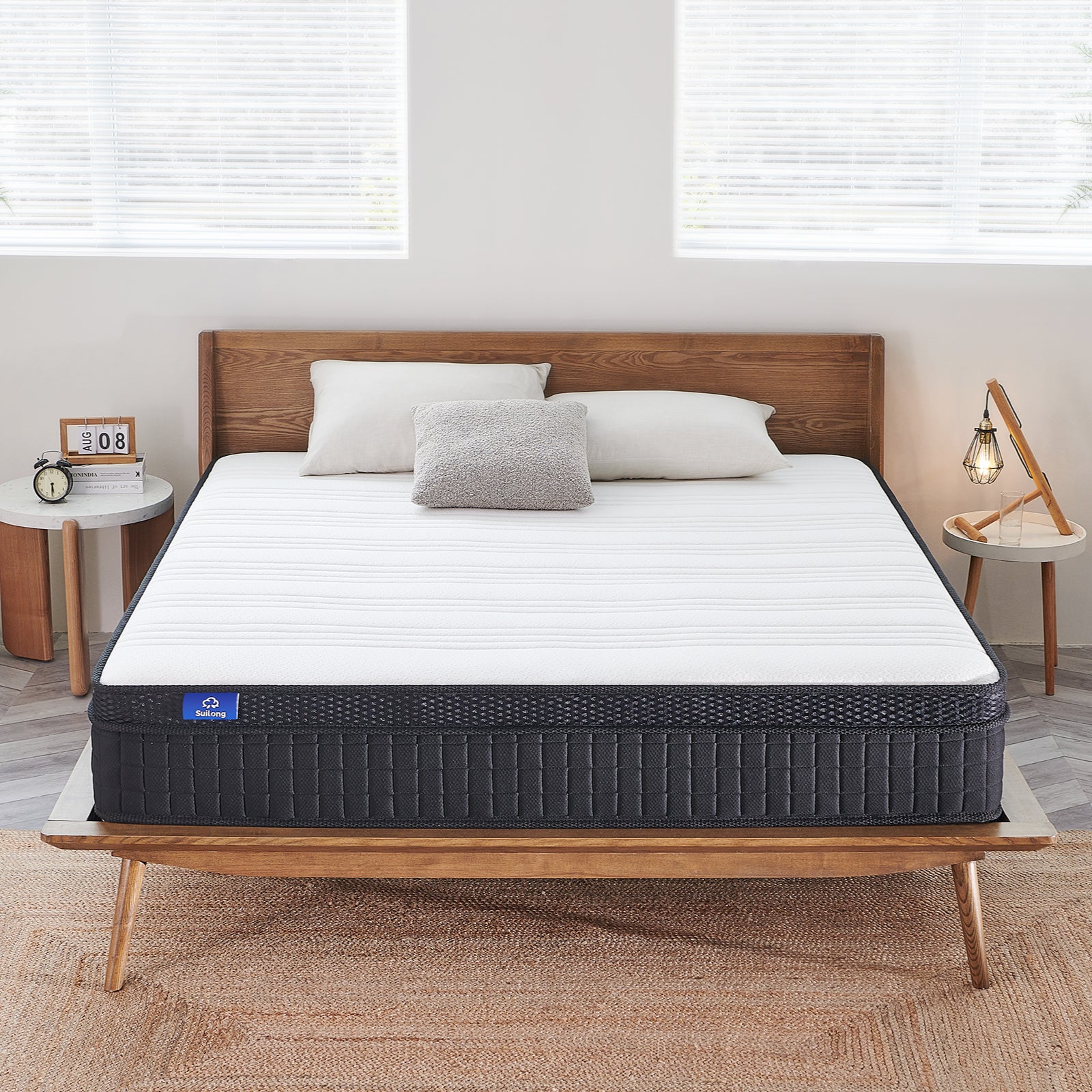How To Choose Mattress For Different Climates?

Explore the perfect mattress for every climate with our expert guide. Learn how to choose the right mattress, from memory foam to hybrids, for summer heat or winter cold, and ensure ideal sleep comfort.
1. Mattresses and climate: finding the perfect mattress for you
As a professional in the mattress manufacturing industry, I know that choosing the right mattress for different climates is critical to getting a good night's sleep. Below is my in-depth discussion of this topic.
1.1 How to recognise the right mattress for you
Firstly, understanding your needs is the key to choosing the right mattress. Everyone has a different body structure and sleeping habits, which means everyone has different needs for a mattress. For example, if you prefer a soft, breathable feel, a twin memory foam mattress' might be ideal. For those who need more support, hybrid mattresses may be more appropriate. When evaluating a mattress, it is important to consider its support, comfort and ability to adapt to the climate.
1.2 Choosing the right mattress for summer and winter
For the summer months, breathability is the key to choosing a mattress. A breathable mattress such as mattress in a box can help regulate the summer heat and keep you cool. In winter, insulation is a key factor. A well insulated full size mattress in a box can help maintain the right body temperature, keeping you warm and cosy on cold nights.
1.3 Memory foam mattress performance in hot climates
Many people worry that memory foam mattresses will overheat in tropical climates. In fact, modern memory foam technology is able to manage temperature effectively. For example, some memory foam mattresses use advanced cooling technology to provide a cooler sleeping environment on hot nights. When choosing this type of mattress, look at the description of the temperature regulation feature to ensure it meets your needs in a tropical climate.
Next, we'll dive into the relationship between mattress technology and climate regulation to learn how to choose a mattress that adapts to your body temperature.
2. Mattress Technology and Climate Regulation
As we explore the world of mattresses, we'll find that mattress technology plays a key role in adapting to different climates. Let's look at how we can utilise these technologies to improve our sleep experience.
2.1 How mattresses adapt to body temperature
Different types of mattresses use different technologies to adapt to body temperature. For example, some memory foam mattresses have built-in thermo-adjusting materials that adjust their firmness and softness according to the body's heat, providing a more personalised sleep experience. In addition, hybrid mattresses combine traditional springs with modern foam technology to provide support while maintaining the right sleeping temperature.
2.2 Is cooling technology in mattresses worthwhile?
Cooling technologies in modern mattresses, such as gel memory foam, have been shown to be particularly effective in improving the sleep experience in the tropics or summer months. These technologies help to maintain a cool feel on the surface of the mattress by dispersing body heat. Considering the impact of heat on sleep quality, investing in a mattress with efficient cooling technology is definitely worthwhile.
2.3 Ideal mattress sleeping temperature
The ideal sleeping temperature is usually between 16 and 18 degrees centigrade. Within this temperature range, the body is able to naturally relax and fall into a deep sleep. Therefore, it is important to choose a mattress that helps to maintain this temperature range. Whether it's a mattress in a box or a traditional style, choosing a mattress that offers good temperature regulation will help improve your overall sleep quality.
Next, we'll discuss mattress acclimatisation and maintenance, explore why you need to wait 72 hours for a new mattress to be ready for use, and how to keep your mattress cool during the summer months.
3. Mattress acclimatisation and maintenance
Once you've chosen your ideal mattress, it's important to understand its adaptability and how to maintain it. This will not only help you enjoy your new mattress better, but also extend its life.
3.1 Why you need to wait 72 hours for a new mattress
When you buy a new mattress in a box, you usually need to give it some time to fully unfold and settle in. This process can take up to 72 hours. This is because the mattress has been tightly compressed during the packing process and needs time to return to its original shape and comfort. Giving your mattress ample time to unfold will ensure you enjoy its full support and comfort.
https://suilong.org/blogs/blogs/unboxing-guide
3.2 Solutions to high sleeping temperatures
If you find that you are sleeping at too high a temperature during the summer months, choosing the right mattress is vital. A breathable twin memory foam mattress or a mattress with cooling technology can be a good choice. Breathable sheets and lightweight bedding can also help to reduce body temperature during sleep.
3.3 Routine maintenance of the mattress
Regular maintenance is essential to keep your mattress comfortable and hygienic. It is recommended to flip or rotate the mattress every two to three months to prevent indentation in one area with prolonged use. To clean your mattress, use a hoover to gently remove surface dust and mites, and for stains, use a specialised cleaner and a gentle scrubbing method.
Next, we'll delve into mattress material selection, how to choose the best mattress material for your climate and personal preferences, including special advice for allergies.
4. Mattress materials and climate suitability
Understanding how different mattress materials adapt to various climatic conditions is essential to choosing the best mattress. Different materials respond differently to temperature and humidity, which affects their performance in different climates.
4.1 Natural vs. synthetic materials
Natural materials, such as latex or wool, typically offer good breathability and temperature regulation, making them ideal for warm or humid climates. In contrast, synthetic materials such as memory foam, although excellent in terms of support, may not be as breathable as natural materials. For example, a king size mattress and box spring may feel hotter on a hot summer day if it is made with high-density memory foam. These factors need to be taken into account when choosing.
4.2 Special needs: allergy-friendly mattresses
For people with allergies, it is important to choose a mattress that is anti-mite and anti-allergenic. Natural materials such as latex and organic cotton usually perform better in this respect as they are naturally antibacterial and mite resistant. In addition, ensure that the mattress is cleaned regularly to minimise the build-up of allergens.
4.3 Environmental friendliness of mattresses
Sustainability and environmental friendliness is another important aspect of modern mattress manufacturing. Choosing mattresses made from eco-friendly materials, such as organic cotton or recycled materials, is not only good for the environment, but also provides consumers with a healthy and safe sleeping environment. When choosing a full size mattress in a box, knowing the product's environmental credentials and manufacturing process can help you make a more responsible choice.
Next, we'll move on to the mattress buying guide section, which offers practical advice and tips to help you choose the best mattress for your climate and personal needs.
5. Mattress Buying Guide
In this final leg of our mattress selection journey, I will provide you with some practical buying guides and tips to ensure that you find the best mattress for your climate and personal needs.
5.1 How to choose the right mattress for your climate
The first things to consider when choosing a mattress for your climate are temperature and humidity. In hot or humid climates, it is vital to choose a mattress that breathes well. For example, latex or mattress in a box styles usually offer better breathability. In colder climates, choosing a mattress that retains warmth, such as a memory foam mattress, is more comfortable.
5.2 Considerations when buying a mattress online
When buying a mattress online, it is important to read product descriptions and user reviews carefully. Check the material, size, and its temperature adjustment function. It's also critical to understand the return policy and warranty terms to ensure that you are protected in your purchasing decision.
5.3 Long-term benefits of investing in a mattress
Choosing a high-quality mattress is an investment in your long-term health and quality of sleep. While high-quality mattresses may cost more initially, they are typically more durable and provide long-lasting support and comfort. Additionally, the impact of a good night's sleep on your overall health and daily life is priceless.
As we come to the end of our mattress selection guide, I hope this information helps you find the perfect mattress to enhance your quality of sleep. Remember, choosing the right mattress is an important decision that will have a direct impact on your quality of life. Now, let's get started on this journey to find your ideal mattress!
FAQs
Q1: What type of mattress is best for hot climates?
A1: In hot climates, a mattress with good breathability, like those made of latex or featuring cooling technologies, is ideal to help regulate temperature and ensure a cooler sleep.
Q2: Can memory foam mattresses be comfortable in warm weather?
A2: Yes, modern memory foam mattresses often incorporate cooling technologies such as gel infusions to help disperse heat and maintain a comfortable sleeping temperature.
Q3: How does mattress material affect sleep in different climates?
A3: Natural materials like latex and wool offer good breathability for warm climates, while memory foam provides excellent insulation for colder environments.
Q4: What should I look for in a mattress if I have allergies?
A4: If you have allergies, look for hypoallergenic mattresses made from natural materials like latex, which resist dust mites and mold.
Q5: How often should I rotate my mattress, and why?
A5: It's recommended to rotate your mattress every two to three months to prevent indentations and uneven wear, which helps prolong its lifespan.
Q6: What are the benefits of hybrid mattresses?
A6: Hybrid mattresses combine the support of innerspring with the comfort of foam or latex, offering a balance of support, comfort, and temperature regulation.
Q7: Is there a recommended temperature for optimal sleep?
A7: The ideal sleeping temperature is usually between 16 to 18 degrees Celsius (60 to 64 degrees Fahrenheit), which a well-chosen mattress can help maintain.
Q8: What should I consider when buying a mattress online?
A8: When buying online, carefully read product descriptions and reviews, focusing on material, size, and temperature regulation features. Also, check the return policy and warranty.
Q9: Why do new mattresses in a box need time to expand?
A9: New 'mattresses in a box' need time, typically up to 72 hours, to fully expand and regain their shape after being compressed for shipping, ensuring the best support and comfort.
Q10: How do I maintain an ideal sleep temperature during summer?
A10: Besides choosing a breathable mattress, use light bedding, and consider room cooling methods like fans or air conditioning to maintain a comfortable sleep temperature in summer.


















